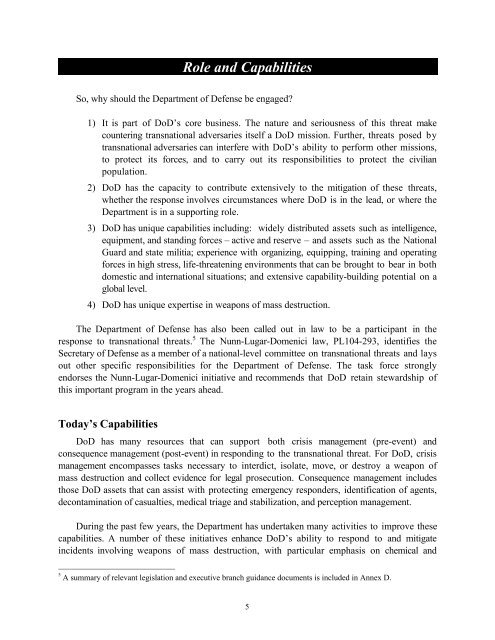DoD Responses to Transnational Threats - The Black Vault
DoD Responses to Transnational Threats - The Black Vault
DoD Responses to Transnational Threats - The Black Vault
Create successful ePaper yourself
Turn your PDF publications into a flip-book with our unique Google optimized e-Paper software.
Role and Capabilities<br />
So, why should the Department of Defense be engaged?<br />
1) It is part of <strong>DoD</strong>’s core business. <strong>The</strong> nature and seriousness of this threat make<br />
countering transnational adversaries itself a <strong>DoD</strong> mission. Further, threats posed by<br />
transnational adversaries can interfere with <strong>DoD</strong>’s ability <strong>to</strong> perform other missions,<br />
<strong>to</strong> protect its forces, and <strong>to</strong> carry out its responsibilities <strong>to</strong> protect the civilian<br />
population.<br />
2) <strong>DoD</strong> has the capacity <strong>to</strong> contribute extensively <strong>to</strong> the mitigation of these threats,<br />
whether the response involves circumstances where <strong>DoD</strong> is in the lead, or where the<br />
Department is in a supporting role.<br />
3) <strong>DoD</strong> has unique capabilities including: widely distributed assets such as intelligence,<br />
equipment, and standing forces – active and reserve – and assets such as the National<br />
Guard and state militia; experience with organizing, equipping, training and operating<br />
forces in high stress, life-threatening environments that can be brought <strong>to</strong> bear in both<br />
domestic and international situations; and extensive capability-building potential on a<br />
global level.<br />
4) <strong>DoD</strong> has unique expertise in weapons of mass destruction.<br />
<strong>The</strong> Department of Defense has also been called out in law <strong>to</strong> be a participant in the<br />
response <strong>to</strong> transnational threats. 5 <strong>The</strong> Nunn-Lugar-Domenici law, PL104-293, identifies the<br />
Secretary of Defense as a member of a national-level committee on transnational threats and lays<br />
out other specific responsibilities for the Department of Defense. <strong>The</strong> task force strongly<br />
endorses the Nunn-Lugar-Domenici initiative and recommends that <strong>DoD</strong> retain stewardship of<br />
this important program in the years ahead.<br />
Today’s Capabilities<br />
<strong>DoD</strong> has many resources that can support both crisis management (pre-event) and<br />
consequence management (post-event) in responding <strong>to</strong> the transnational threat. For <strong>DoD</strong>, crisis<br />
management encompasses tasks necessary <strong>to</strong> interdict, isolate, move, or destroy a weapon of<br />
mass destruction and collect evidence for legal prosecution. Consequence management includes<br />
those <strong>DoD</strong> assets that can assist with protecting emergency responders, identification of agents,<br />
decontamination of casualties, medical triage and stabilization, and perception management.<br />
During the past few years, the Department has undertaken many activities <strong>to</strong> improve these<br />
capabilities. A number of these initiatives enhance <strong>DoD</strong>’s ability <strong>to</strong> respond <strong>to</strong> and mitigate<br />
incidents involving weapons of mass destruction, with particular emphasis on chemical and<br />
5<br />
A summary of relevant legislation and executive branch guidance documents is included in Annex D.<br />
5





![Combat Support in Korea [270 Pages] - The Black Vault](https://img.yumpu.com/49796461/1/190x71/combat-support-in-korea-270-pages-the-black-vault.jpg?quality=85)











